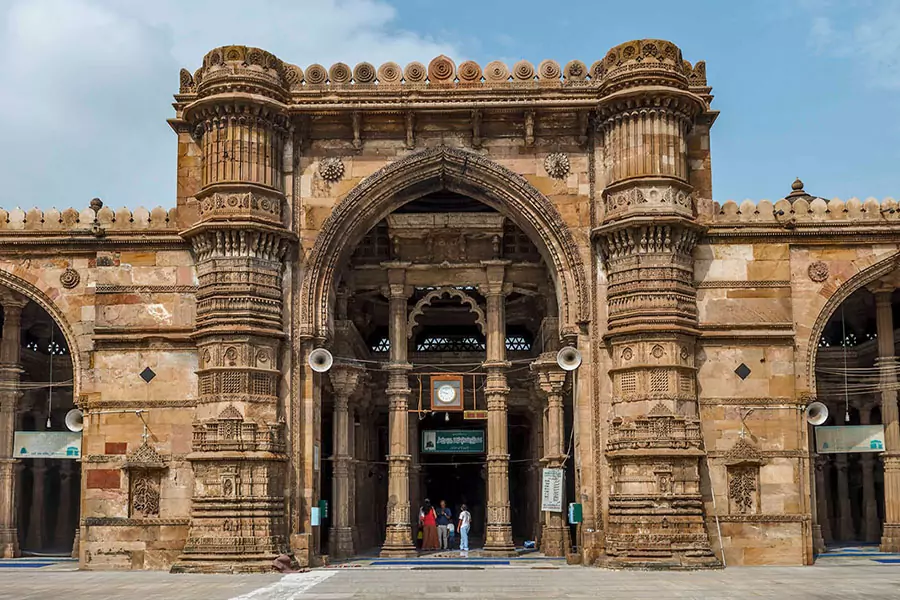Uparkot Fort in Junagadh, Gujarat – Places to visit

Visiting the Uparkot Fort is a must when in Junagadh, Gujarat. If the city didn’t have the majestic Mahabat Maqbara mausoleum, I would say the Uparkot Fort is a centerpiece of Junagadh, but my loyalty is forever with the former. Even so, the Uparkot fort is definitely a worthy sight that shouldn’t be underestimated, and I would highly recommend to include it into your Junagadh itinerary if you happen to make a trip to this part of India. Whether you’re an architecture enthusiast, history aficionado, or nature lover, this place is bound to please your senses and intrigue your mind.
Historical note
Located at the foot of the Girnar mountain, the ancient fort offers breathtaking views over the misty hills. It was established during the reign of the Maurya Empire (a powerful force that dominated the territories of present-day India up to 188 BC). During the upcoming centuries, Uparkot fort was used as a seat of power by various dynasties, including Guptas.
According to some research, it was even ruled by the Greeks for a few years: one of the rock edicts in this area mentions Tushapsha the Yavana raja (Greek king).
Needless to say, the fort was under siege countless times. One of them lasted for as long as twelve years. It lost its significance as a strategic object when the capital of the region was transferred from Junagadh to another city during the rule of the Maitraka dynasty. The importance of the Uparkot fort was not reclaimed until the 10th century when it was rediscovered and freed from the jungle.
Uparkot fort: places to see within its walls
One gets to enter the fort through three gateways, each of them located inside the other. Near the gate, there were some locals offering the services of guides. I can’t say how knowledgeable they were as none of them spoke English. And even if they did, most probably I would have decided to explore the place on my own. It’s easy to navigate inside the fort, and although the upkeep was obviously lacking, there were lots of informative boards. So these are the places I’ve visited within the Uparkot fort’s walls:
Neelam and Manek

These two are the twin cannons that were transported to Junagadh from Diu after the defeat in battle against the Portuguese invaders in the 16th century. The cannons belonged to the Turkish Naval Forces whose support was requested by the local Gujarat Sultanate. The Turks left the cannons behind when fleeing back to their homeland, and later these two giant guns were taken to the Uparkot fort where they found a new home.
Jamma Masjid

Close to Neelam and Manek there is an ancient one-storey structure that obviously bears some traces of the glory bygone. According to the the Archaeological Survey of India’s board, it’s the Ranakdevi Mahal, which was converted into a mosque when the fort was captured by Mahmud Begada. This place is not to be missed when exploring the Uparkot fort in Junagadh – apart from a beautiful pillared hall and exquisite carvings, it also features a terraced roof which can be easily accessed by a flight of stairs. From the roof, you can admire the most breathtaking views: over the misty mountains from one side, and over the sprawling city from the other.

With Gujarat being renowned for some of the most intricate and opulent stepwells (Adalaj Stepwell and Rani ki Vav to name a couple), it’s only natural for a curious visitor to expect seeing a stepwell or two in Junagadh as well. In this respect, one can find their visit to the Uparkot fort rather rewarding – it does features some rather unusual examples of this architectural form. They are nothing like the imposing architectural wonders you can find elsewhere across Gujarat, but their conspicuous, defiant aesthetics makes them nothing short of unique.
The first one, Adi-Kadi Vav, is known for its fantastic rock strata along the walkway. You can read more about the Adi Kadi Stepwell in Junagadh in this post:
As for the Navaghan Kuvo, it’s a simple unembellished stepwell with a broad staircase leading to the bottom of the structure. It was named after one of the local rulers who reigned here in the 11th century. That said, it is believed that the stepwell is much older than that, and it’s not excluded that Navaghan Kuvo is actually one of the most ancient stepwells of India.
Buddhist Caves
There is also a double-story Buddhist cave complex within the ramparts of the Uparkot fort that dates back to the 2nd or 3rd century. As most of Buddhist rock-cut shelters in India, these caves were used by monks and occasional travelers and traders as living quarters and place for praying and meditating. Some of rather exquisite pillars and beautiful carvings can be found in the Uparkot caves.
Entry fee and timings
The fort is open from 7 o’clock in the morning to 7 o’clock in the evening, and the entry fee is more than affordable – it’s only Rs 5 for Indian visitors and Rs 100 for foreigners. As I recall, I wasn’t charged any additional fees for taking pictures.



